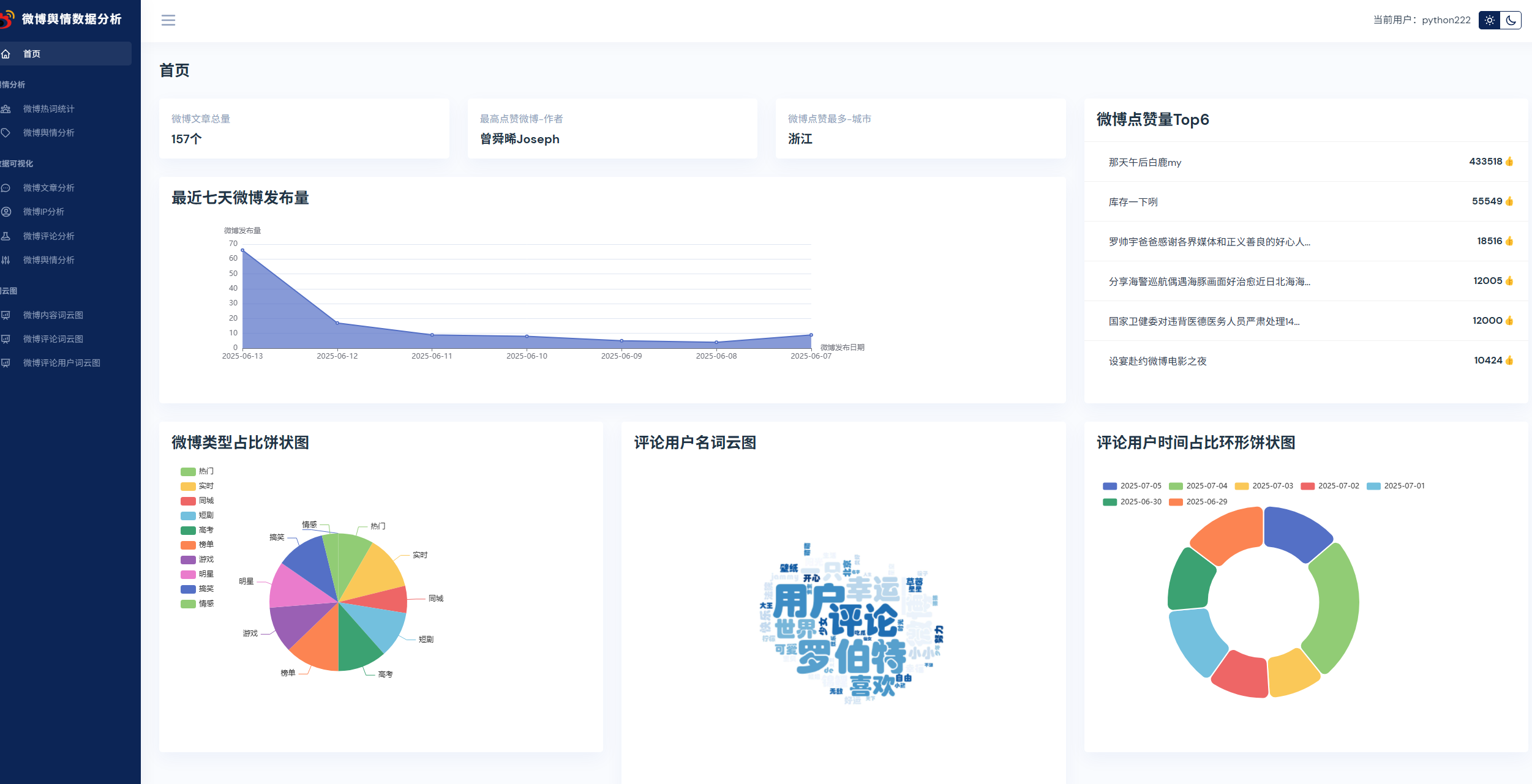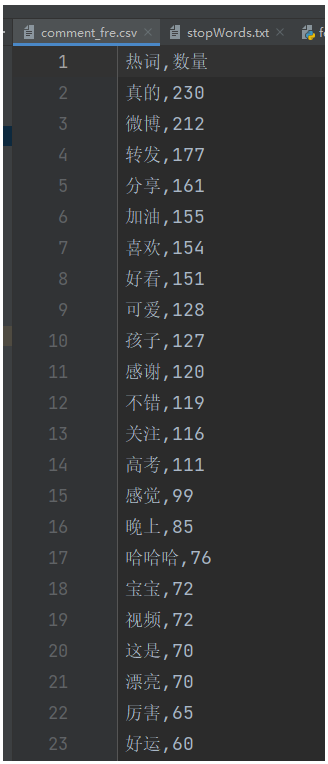【NLP舆情分析】基于python微博舆情分析可视化系统(flask+pandas+echarts) 视频教程 - 基于jieba实现词频统计
大家好,我是java1234_小锋老师,最近写了一套【NLP舆情分析】基于python微博舆情分析可视化系统(flask+pandas+echarts)视频教程,持续更新中,计划月底更新完,感谢支持。今天讲解 基于jieba实现词频统计
视频在线地址:
2026版【NLP舆情分析】基于python微博舆情分析可视化系统(flask+pandas+echarts+爬虫) 视频教程 (火爆连载更新中..)_哔哩哔哩_bilibili
课程简介:

本课程采用主流的Python技术栈实现,Mysql8数据库,Flask后端,Pandas数据分析,前端可视化图表采用echarts,以及requests库,snowNLP进行情感分析,词频统计,包括大量的数据统计及分析技巧。
实现了,用户登录,注册,爬取微博帖子和评论信息,进行了热词统计以及舆情分析,以及基于echarts实现了数据可视化,包括微博文章分析,微博IP分析,微博评论分析,微博舆情分析。最后也基于wordcloud库实现了词云图,包括微博内容词云图,微博评论词云图,微博评论用户词云图等功能。
基于jieba实现词频统计
我们来实现下微博舆情热词分析,对微博评论信息进行词频统计。
首先第一步,从数据库获取所有微博评论信息,然后遍历每条评论信息,进行分词,过滤掉停用词,最后统计出每个词出现的次数,排个序,就能找到热词。
第一步,数据库查询所有评论信息。
通过Pymsql实现,先定义一个dbUtil.py数据库工具类
"""数据库连接工具作者 : 小锋老师官网 : www.python222.com
"""
from pymysql import Connection
def getCon():"""获取数据连接:return: 数据库连接"""con = Connection(host="localhost", # 主机名port=3308, # 端口user="root", # 账户password="123456", # 密码database="db_weibo", # 数据库autocommit=True # 设置自动提交)return con
def closeCon(con: Connection):"""关闭数据库连接:param con: 数据库连接:return:"""if con:con.close()再新建commentDao.py,操作评论信息的数据访问对象,实现查询所有评论信息的方法
"""用户评论信息 数据访问对象
"""
from util import dbUtil
def getAllComment():"""获取所有评论信息:return:"""con = Nonetry:con = dbUtil.getCon()cursor = con.cursor()sql = "SELECT * from t_comment where text!=''"cursor.execute(sql)return cursor.fetchall()except Exception as e:print(e)con.rollback()return Nonefinally:dbUtil.closeCon(con)jieba分词后,我们还需要进行过滤过滤数据,单个字以及停顿词。

词频统计实现代码:
"""
微博评论信息分词 词频统计
"""
import re
import jieba
import pandas as pd
from dao import commentDao
def outCommentFreToCsv(sorted_wfc_list):"""词频统计后,写入到csv:param sorted_wfc_list::return:"""df = pd.DataFrame(sorted_wfc_list, columns=['热词', '数量'])df.to_csv('comment_fre.csv', index=False)
def getStopWordsList():"""获取停顿词:return:"""return [line.strip() for line in open('stopWords.txt', encoding='UTF-8').readlines()]
def cut_comment():"""分词:return:"""allCommentStr = " ".join([comment[1].strip() for comment in commentDao.getAllComment()])seg_list = jieba.cut(allCommentStr) # 精准模式分词return seg_list
def word_fre_count():"""词频统计 过滤数据,单个字以及停顿词:return:"""seg_list = cut_comment()stopWord_list = getStopWordsList()# 正则去掉数字,单个字以及停顿词new_seg_list = []for s in seg_list:number = re.search('\d+', s)if not number and s not in stopWord_list and len(s) > 1:new_seg_list.append(s)
# 词频统计wfc = {}for w in set(new_seg_list):wfc[w] = new_seg_list.count(w)
# 排序sorted_wfc_list = sorted(wfc.items(), key=lambda x: x[1], reverse=True)return sorted_wfc_list
if __name__ == '__main__':# print("/".join(cut_comment()))# print(getStopWordsList())outCommentFreToCsv(word_fre_count())运行后,写入到csv文件。

